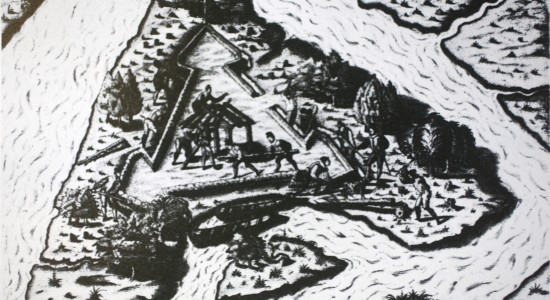
Last month,at a conference in Tallahassee, two researchers–Crowe and Spring–gave a public presentation to announce their theory that the 1565 French colony of La Caroline was not in present-day Jacksonville, Florida, but some 70 miles to the north near Darien, Georgia. The evidence they presented to support this alternate hypothesis was not convincing to many of the scholars present at the post-presentation debate, including LAMP Director Chuck Meide.
From the March 15 edition of Ancient City News:
St Augustine Lighthouse Archaeologist, Chuck Meide, told Historic City News that he traveled to Tallahassee recently to challenge claims by scholars, Fletcher Crowe and Anita Spring, that French-occupied Ft Caroline is not actually located near Jacksonville, as we have been led to believe, but rather located along the St Mary’s River in Georgia.
Academic scholars presented the findings they have developed during course of their research. Their theory is that Ft Caroline was some 70-miles north, but Meide says that there are a number of problems with the evidence that was presented at the conference.
“First of all, it is problematic to use 16th century maps to determine an exact geographical location with any precision; as they are notoriously inaccurate and often mistakes were copied and re-copied by cartographers who had never even visited the New World,” Meide explained. “For every map presented that seemed to show the River of May further north — we could find another in which it is depicted in the Jacksonville area.”
Meide and several other archaeologists have spent years researching French and Spanish records from the 16th century to determine where French captain Jean Ribault’s fleet sank as they tried to sneak into St Augustine. This summer, Meide and his team from the St Augustine Lighthouse and Museum are planning an expedition to find the lost fleet.
The relationship between the location of St Augustine and the location of Ft. Caroline is a big piece of the puzzle that plays heavily into Meide’s dispute. He told local reporters that what we know about the location of St Augustine is the most glaring problem with the Altamaha River theory.
“We know that Menendez marched his men from St Augustine on September 18 to attack the French, and they successfully sacked Fort Caroline on September 20,” Meide said. “That is a two-day march through hurricane-force winds and rain. It’s not conceivable, in those conditions, that the soldiers could have made it to the Altamaha River from St Augustine in two days.”
It is well-known that the Spanish moved the settlement of St Augustine twice; first from its original location at the Indian village of Seloy, to Anastasia Island, and then from the island to its final location at present-day downtown St Augustine.
Spring and Crowe indicated that they believe St Augustine was actually founded further north, at the mouth of the St Mary’s River; although there is no evidence of that. In fact, extensive research and excavation by archaeologist Kathy Deagan, has produced a significant body of archaeological evidence that St Augustine’s original settlement site was at the present-day Fountain of Youth Archeological Park.
“If Crowe and Spring are correct, that means the Spanish would have moved the St Augustine settlement 70 miles south, from the St Mary’s River, to its present location. There is simply no evidence for this,” said Meide.
For a timeline of media events related to the Fort Caroline controversy, click here.

